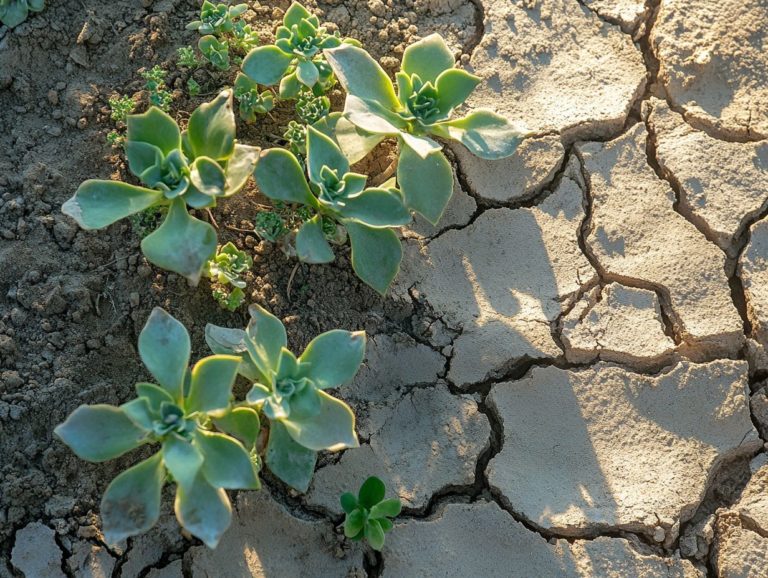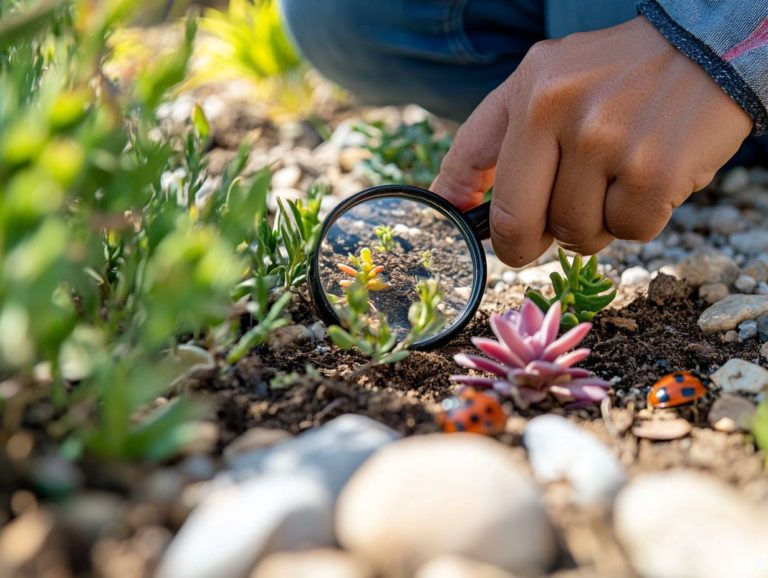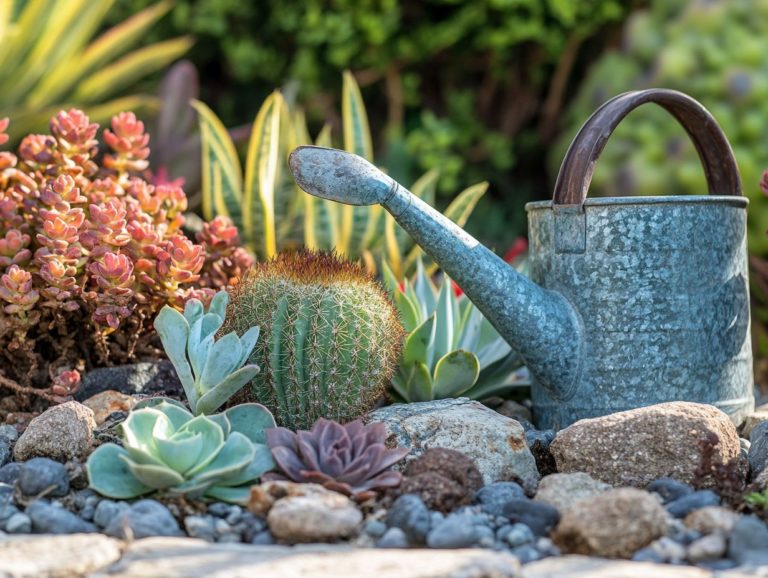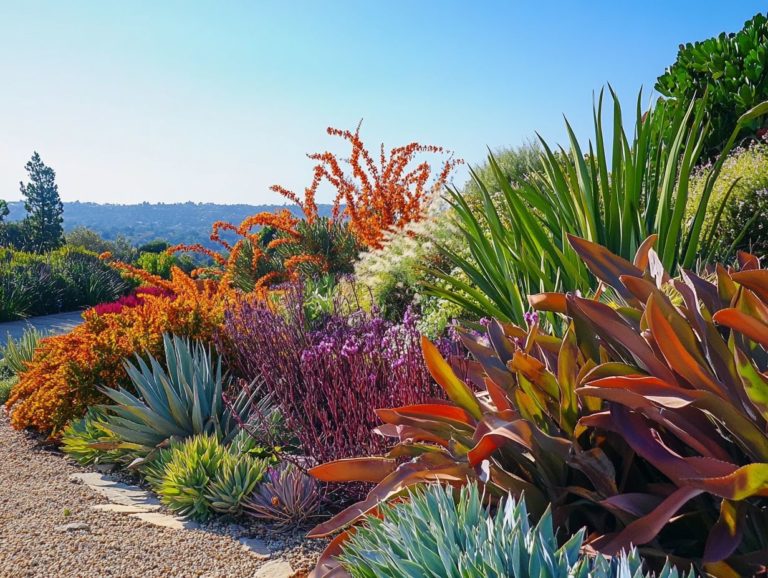How to Design a Drought-Resistant Landscape?
Drought-resistant landscapes are becoming increasingly vital in today s changing climate, providing aesthetic beauty and practical advantages.
This guide will equip you with the essentials to design a landscape that thrives in the driest conditions. You ll explore what defines drought resistance, the key factors for your outdoor space, and the types of plants that can flourish with minimal water.
You ll also find valuable maintenance tips to keep your landscape vibrant and sustainable for years to come.
Dive in and transform your garden into a resilient oasis!
Contents
- Key Takeaways:
- Understanding Drought-Resistant Landscapes
- Assessing Your Landscape for Drought Resistance
- Designing a Drought-Resistant Landscape
- Types of Plants and Their Benefits
- Maintenance and Care for Drought-Resistant Landscapes
- Frequently Asked Questions
- 1. Can I create a beautiful landscape while still being drought-resistant?
- 2. What types of plants are best for a drought-resistant landscape?
- 3. How do I minimize water usage in a drought-resistant landscape?
- 4. Can I still have a lawn in a drought-resistant landscape?
- 5. Is it possible to have a variety of colors and textures in a drought-tolerant landscape?
- 6. How do I maintain a drought-resistant landscape?
Key Takeaways:
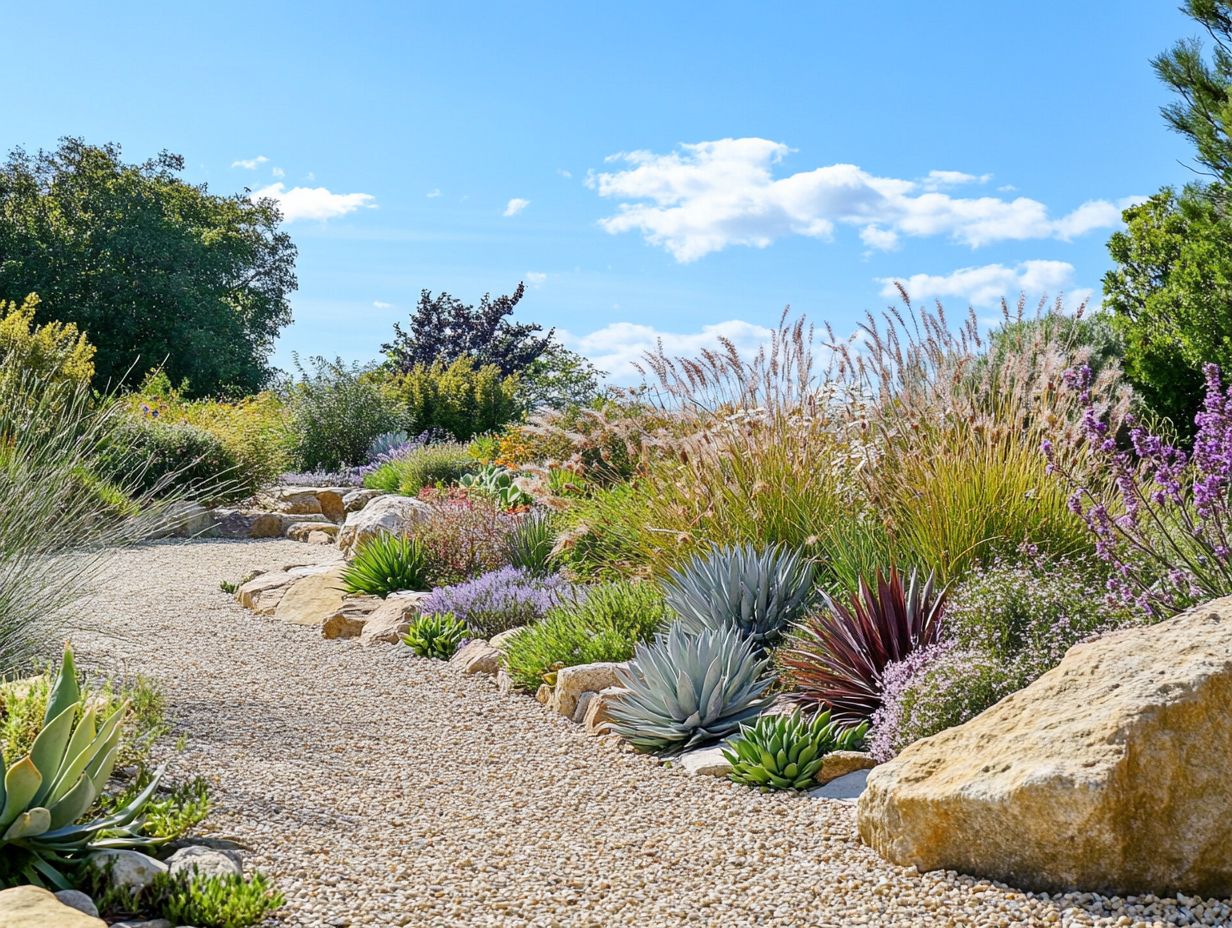
- Incorporate drought-resistant elements to save water and cut down on maintenance.
- Assess soil type, sun exposure, and local climate when designing your landscape.
- Choose native plants with low water needs, and follow proper care methods for lasting success.
Understanding Drought-Resistant Landscapes
Understanding the role of drought-resistant plants in landscaping is essential in today’s world, where climate change is causing water scarcity and unpredictable weather patterns.
Embracing drought-tolerant landscaping conserves water resources, fosters biodiversity, and enhances your outdoor spaces, making them more resilient to environmental challenges.
By applying water-saving gardening techniques, you can cultivate beautiful, sustainable gardens that significantly reduce water consumption and contribute to healthier ecosystems.
Definition and Benefits
Drought-resistant landscapes are designed to thrive in arid conditions while reducing water consumption, and understanding how to use drought gardening principles in landscaping plays a crucial role in water conservation and ecological sustainability.
These thoughtful designs often feature native plants and materials suited to your local climate, creating a seamless connection between your outdoor spaces and the surrounding environment. By adopting these landscaping practices, you can greatly diminish your water usage, which lowers your utility bills and promotes biodiversity.
Such landscapes combat soil erosion and runoff, improving overall soil health. The long-term advantages include reduced maintenance demands and enhanced resilience against climate fluctuations, making drought-resistant landscaping a smart investment for future generations.
Assessing Your Landscape for Drought Resistance
Assessing your landscape for drought resistance requires a keen understanding of soil conditions, local climate nuances, and the irrigation systems available to you.
Evaluating these factors helps you identify the best strategies for creating a sustainable garden design that thrives in tough conditions.
Factors to Consider
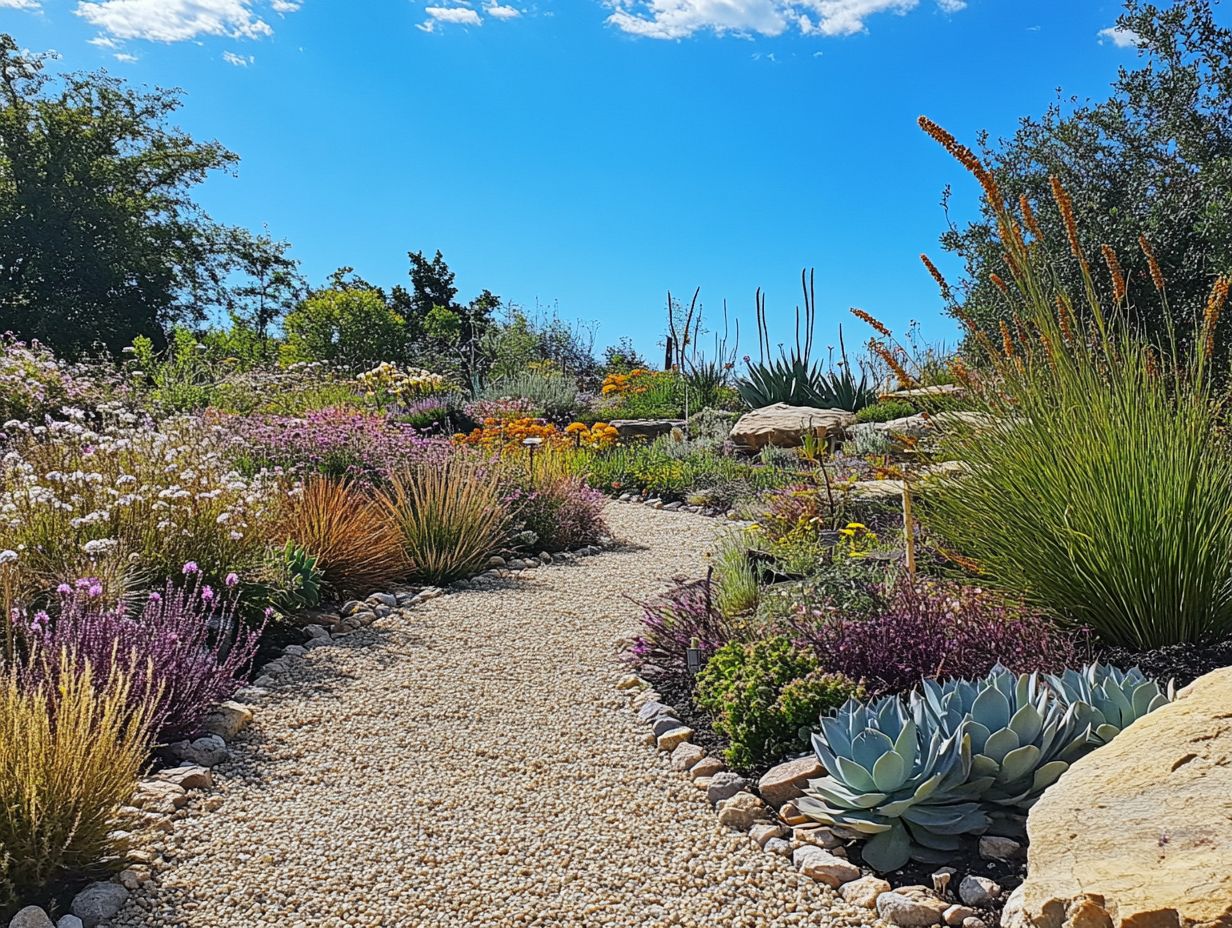
When assessing your landscape for drought resistance, consider key factors like drought adaptation strategies, native plants, and how to prepare soil for drought-resistant plants to improve moisture retention in the soil.
These elements optimize water usage, foster biodiversity, and enhance resilience against extreme weather. By selecting native plants suited to your local climate, you can significantly reduce the need for extra watering, as these species naturally thrive in your region with minimal maintenance.
Implementing efficient irrigation systems, like drip irrigation, ensures that water is delivered precisely where it’s needed, minimizing waste and maximizing efficiency. Additionally, using moisture retention techniques, such as applying mulch and soil amendments, can boost the soil’s capacity to hold water, sustaining your plants during prolonged dry spells.
Start creating your drought-resistant landscape today! Your garden will thank you.
Designing a Drought-Resistant Landscape
Designing a drought-resistant landscape demands careful planning, emphasizing water-efficient principles and the thoughtful incorporation of organic matter. You’ll want to select garden beds that enhance plant health while optimizing moisture retention. For more detailed strategies, check out this guide on how to design a drought-tolerant landscape. This approach ensures your outdoor space thrives even in challenging conditions.
Key Elements and Features
The key elements of a drought-resistant landscape include water-efficient slopes and the strategic use of mulch to lock in moisture. For more detailed strategies, check out how to maintain drought-resistant landscapes. Implementing drip irrigation, a method of watering plants directly at their roots, optimizes water usage.
These components work together to create a system that conserves water and nurtures healthier soil ecosystems. By incorporating permaculture techniques, you’ll enhance biodiversity and establish natural habitats that flourish even with limited water.
Drought-tolerant plants play a pivotal role, requiring less water while providing essential ground cover that helps prevent soil erosion. With careful planning, these landscapes can support a vibrant ecosystem and significantly reduce the need for irrigation, ensuring resilience even during the driest spells.
Types of Plants and Their Benefits

Drought-resistant plants encompass a diverse array of species, including native varieties that offer significant environmental advantages, such as improved soil conditions and greater biodiversity.
These resilient plants flourish with minimal water and embody sustainable gardening practices. Selecting options like succulents and ornamental grasses allows you to craft visually stunning landscapes that require little to no irrigation.
It’s crucial to consider your local climate and the specific characteristics of your soil when choosing drought-tolerant species. For example, amending sandy soil with organic matter enhances its moisture retention and supports these hardy plants.
Ultimately, these selections elevate the charm of your garden while championing environmental stewardship.
Maintenance and Care for Drought-Resistant Landscapes
To maintain a drought-resistant landscape, implement specific care practices that emphasize water-efficient techniques. This includes applying mulch strategically and incorporating organic matter to enhance plant health and longevity, as detailed in our guide on how to plan a drought-resistant garden layout.
By adopting these methods, you’ll create a resilient environment that thrives even in challenging conditions.
Tips and Techniques for Long-Term Success
To achieve long-term success in drought-resistant landscaping, prioritize water conservation, optimize your irrigation systems, and enrich your soil with organic matter. For a detailed approach, consider checking out how to plan a drought-resistant garden layout to enhance biodiversity.
Start by embracing drip irrigation or soaker hoses; this simple adjustment significantly reduces water waste, ensuring moisture reaches the plant roots where it’s needed most. Utilizing mulch is another game-changer; it retains soil moisture and suppresses weeds, creating a flourishing environment for your plants.
Soil enrichment is equally vital. By incorporating compost or aged manure, you boost nutrient content and improve soil structure, allowing for better water retention. Introducing native plants and a variety of beneficial insects fosters a balanced ecosystem, making your garden more resilient to drought while providing natural pest control.
Frequently Asked Questions
Start your journey toward a thriving, water-efficient garden today!
1. Can I create a beautiful landscape while still being drought-resistant?
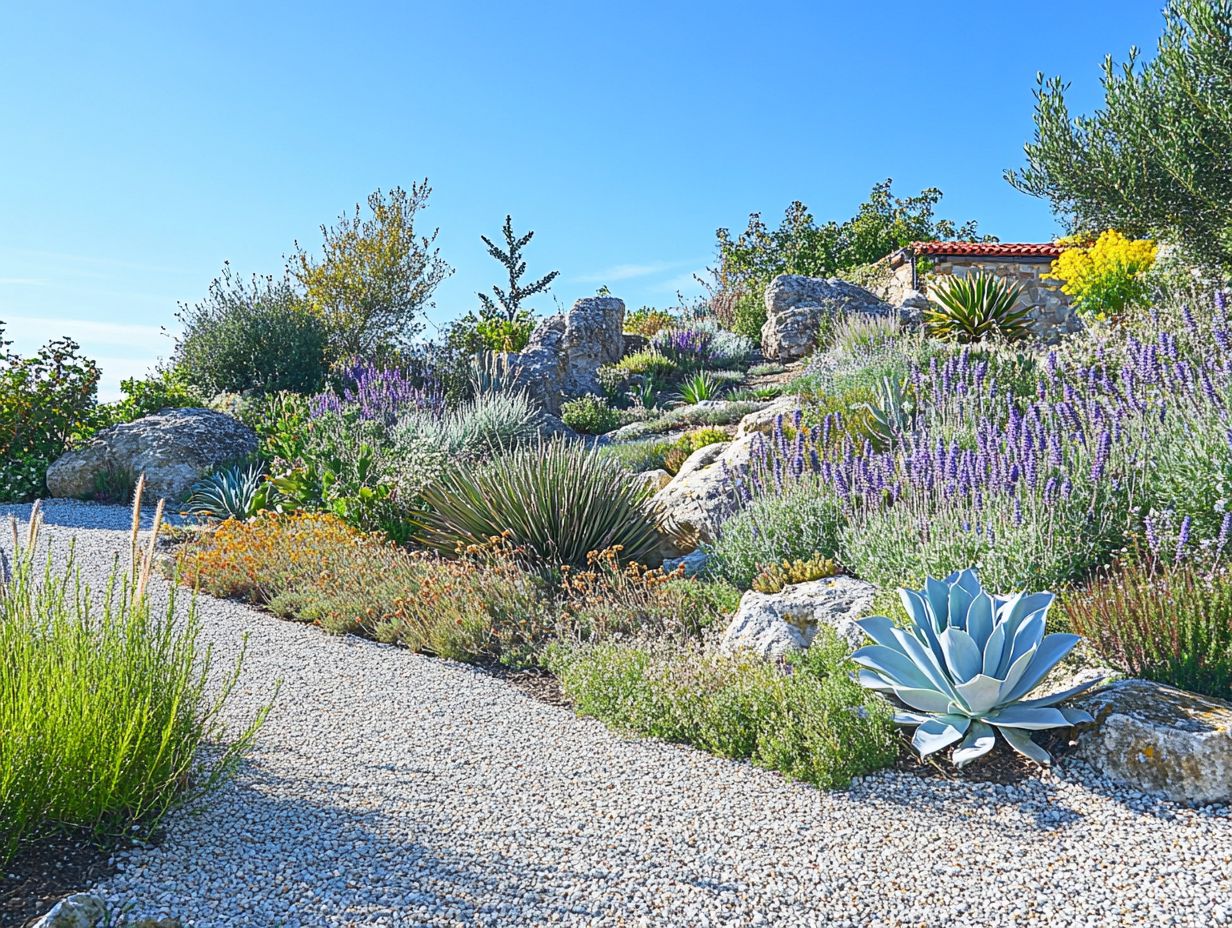
Yes! You can design a drought-resistant landscape that is also beautiful. By learning how to design a drought-tolerant garden, you can choose the right plants and use water-saving strategies to create a stunning, sustainable space.
2. What types of plants are best for a drought-resistant landscape?
Drought-resistant plants work best in these landscapes. To optimize your garden’s resilience, consider learning how to enhance drought resistance in existing gardens. Look for succulents, cacti, and plants with thick, waxy leaves that hold moisture.
3. How do I minimize water usage in a drought-resistant landscape?
You can reduce water usage by using mulch and drip irrigation systems. Grouping plants with similar water needs together is also very effective.
4. Can I still have a lawn in a drought-resistant landscape?
Traditional lawns may not fit well, but you can have a lush lawn by choosing drought-resistant grasses like Bermuda or zoysia grass.
5. Is it possible to have a variety of colors and textures in a drought-tolerant landscape?
Absolutely! You can create a stunning landscape bursting with colors and textures. Mix plants with different colors and textures for a vibrant look.
6. How do I maintain a drought-resistant landscape?
Regular watering and mulching help keep your landscape healthy. Monitor for signs of drought stress and remove weeds and dead plants regularly.


